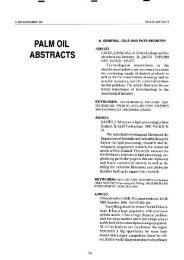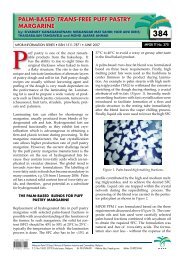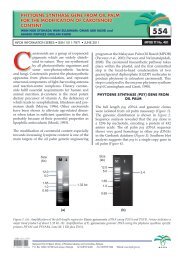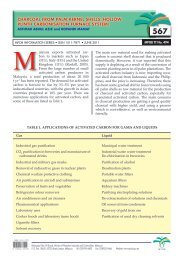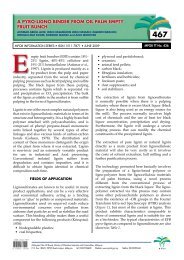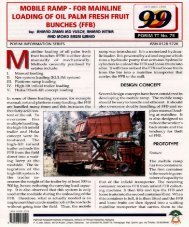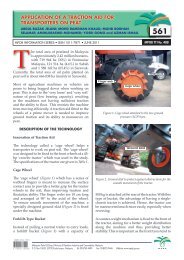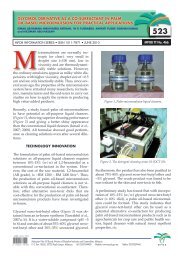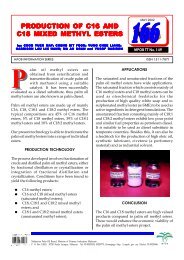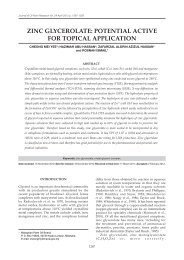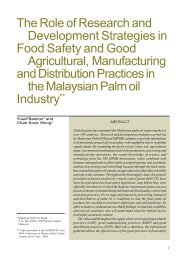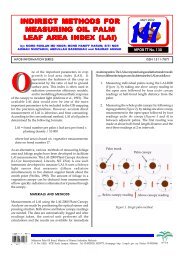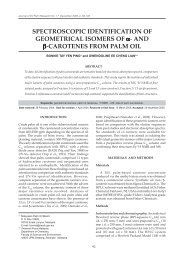physical testing service - particle size analysis - PALMOILIS - MPOB
physical testing service - particle size analysis - PALMOILIS - MPOB
physical testing service - particle size analysis - PALMOILIS - MPOB
You also want an ePaper? Increase the reach of your titles
YUMPU automatically turns print PDFs into web optimized ePapers that Google loves.
PHYSICAL TESTING SERVICE - PARTICLE<br />
SIZE ANALYSIS<br />
by: YEONG, S K; ZAHARIAH, I; ROSNAH, I; ZAFARIZAL, A and SALMIAH, A<br />
305<br />
<strong>MPOB</strong> INFORMATION SERIES • ISSN 1511-7871 • JUNE 2005 <strong>MPOB</strong> TS No. 6<br />
Most of the products which we<br />
encountered daily are<br />
homogeneous mixtures of chemical<br />
species dispersed at a molecular<br />
level. Some of these <strong>particle</strong>s are so<br />
small that they are invisible to our naked eyes.<br />
For example, a microemulsion solution appears<br />
to be clear and colourless. Some of the examples<br />
of dispersion of <strong>particle</strong>s, which we normally<br />
encountered in our daily life, are milk and paint.<br />
Milk is actually dispersion of fat in an aqueous<br />
phase while ink or paint is dispersion of solid<br />
<strong>particle</strong>s (pigments) in a liquid medium. And the<br />
list goes on.<br />
WHY IS PARTICLE SIZE IMPORTANT?<br />
Particle <strong>size</strong> is important for the improvement<br />
of product performance. For example, the time<br />
taken for a drug to release depends very much<br />
on the <strong>particle</strong> <strong>size</strong> of drug. Larger <strong>particle</strong>s take<br />
longer time to release than smaller ones. Particle<br />
<strong>size</strong> also determines the product appearance. For<br />
example, in a liquid foundation, whether matt<br />
finish or shiny finish depend on the <strong>size</strong> of the<br />
titanium dioxide <strong>particle</strong>s. Particle <strong>size</strong> also<br />
determines the emulsion stability thus affects the<br />
product shelf life. Larger <strong>particle</strong>s tend to settle<br />
more quickly than smaller ones and this will lead<br />
to sedimentation.<br />
HOW CAN WE MEASURE<br />
PARTICLE SIZE?<br />
Particle <strong>size</strong> can be measured using a Malvern<br />
Master<strong>size</strong>r or a HPPS (high performance<br />
<strong>particle</strong> <strong>size</strong>r). Malvern Master<strong>size</strong>r (Figure 1)<br />
measures <strong>particle</strong> <strong>size</strong> from 0.02 – 2000 mm while<br />
HPPS measures <strong>particle</strong> from 0.6 nm to 6000 nm<br />
hydrodynamic diameter.<br />
Figure 1. Malvern Master<strong>size</strong>r.<br />
Malvern Master<strong>size</strong>r uses light scattering<br />
technique to measure the <strong>particle</strong> <strong>size</strong> and then<br />
uses the Mie theory to obtain the <strong>size</strong> of various<br />
<strong>particle</strong>s. The key point of the theory is that each<br />
<strong>size</strong> of the <strong>particle</strong> will have its own scattering<br />
pattern, which means if you know the <strong>size</strong> of<br />
the <strong>particle</strong> and other details of the structure, you<br />
can accurately predict the way it scatters the<br />
light. The Master<strong>size</strong>r works backward by using<br />
the optical unit to capture the actual scattering<br />
pattern from a field of <strong>particle</strong>s. Then using the<br />
theory to calculate the <strong>size</strong> of <strong>particle</strong>s.<br />
HPPS uses the dynamic light scattering to<br />
measures Brownian motion and relates this to<br />
<strong>particle</strong> <strong>size</strong>. It does this by illuminating the<br />
<strong>particle</strong>s with a laser and analysing the intensity<br />
fluctuations of the scattering light. An important<br />
feature for HPPS is that it uses the relationship<br />
between the <strong>size</strong> of a <strong>particle</strong> and its speed due<br />
to Brownian motion to obtain the <strong>particle</strong> <strong>size</strong><br />
and this relationship is defined in the Stokes-<br />
Einstein equation.<br />
Malaysian Palm Oil Board, Ministry of Plantation Industries and Commodities, Malaysia<br />
P. O. Box 10620, 50720 Kuala Lumpur, Malaysia. Tel: 03-89259155, 89259775, Website: http://mpob.gov.my Telefax: 03-89259446
SERVICES OFFERED BY PHYSICAL<br />
TESTING LABORATORY<br />
• Particle <strong>size</strong> by Malvern Master<strong>size</strong>r (normal<br />
emulsion)<br />
• Particle <strong>size</strong> by HPPS (microemulsion)<br />
Sample Volume Required<br />
50 ml.<br />
WHEN TO EXPECT FOR RESULTS<br />
Under normal circumstances, client can expect<br />
to receive report within three weeks. In case of<br />
unforeseen circumstances, client will be<br />
informed.<br />
REPORTS<br />
A test report will be sent to client together with<br />
the data printout from the instrument where it<br />
is applicable. Example of data printout is shown<br />
in Figure 2.<br />
Figure 2. An example of <strong>particle</strong> <strong>size</strong> distribution measured using Malvern Master<strong>size</strong>r.<br />
For more information kindly contact:<br />
Director-General<br />
<strong>MPOB</strong><br />
P. O. Box 10620<br />
50720 Kuala Lumpur, Malaysia.<br />
Tel: 03-89259155, 89259775<br />
Website: http://mpob.gov.my<br />
Telefax: 03-89259446



